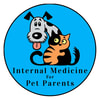|
Has your dog or cat been diagnosed with pneumonia?
Whether your pet has a mild cough or is struggling to breathe, your vet should take thoracic radiographs (chest x-rays) to view the lungs. These images give us vital information about what is happening within the chest. It can reveal an enlarged heart, lung inflammation or infection, fluid or air in the chest where it is not supposed to be, and even masses.
In the images below you'll see the lung fields outlined in white with the major structures labeled. In the image on the left, the normal chest x-ray, the lungs are nice and dark/black in color. You can see the heart outlined because it is denser than the surround lungs. On the image on the right, however, it is extremely difficult to see the outline of the heart and the lung fields are 'whited out'. This is what a pneumonia radiograph looks like.
Pneumonia is described as an infection that causes inflammation in the lungs. This may be in one or many of the lung lobes. Pneumonia can be caused by bacteria, viruses, fungal, protozoal, or parasite infections. The air sacs, or alveoli, of the lungs fill up with fluid or pus. (Want a refresher on anatomy? Visit the respiratory page here.)
Common causes of pneumonia include:
Sometimes a pet may prescribed an antibiotic and it may not work, or it stops working. In this case it may be recommended to have a bronchoscopy and alveolar lavage to see what is in the lungs and to get a sample for cytology and culture. This procedure is done under general anesthesia. A bronchoscopy is when a scope is entered into the trachea, bronchi, and bronchioles and using video the veterinarian can see if there is inflammation, secretions, foreign bodies, and then using the scope a small amount of sterile saline is infused into the lungs and then sucked back out. This sample is then used for cytology (looking at the cells) and culture to see what type of infectious agent is causing the problems. This is a specialized procedure and your primary veterinarian may recommend a consult with a specialist. They have pneumonia, so now what?
The most common respiratory infection in dogs is Bordetella spp., also known as kennel cough. It is a transmissible infection between dogs and can be easily acquired by dogs similar to a cold for people. For most dogs that get Bordetella they have a cough that lingers for a few weeks and then goes away with minimal treatment.
Older dogs, young puppies, or dogs with a decreased immune system can catch Bordetella and it can turn into a serious, or potentially fatal, pneumonia. Treatment for infections include antibiotics or antifungals and sometimes cough suppressants. If the pneumonia is severe enough hospitalization on IV fluids, IV antibiotics, and sometimes oxygen supplementation is needed. Repeat chest radiographs every few days can help show the progress of the pneumonia. After your pet is able to breath regular room air and they are taking medications orally, they will be transitioned home. Your vet may recommend nebulization and coupage to help break up the secretions in the lungs and get them out. This can be accomplished with a nubulizer like the Omron CompAir Nebulizer System NE-C801 available from Just Nebulizers.com, or by placing your pet in the bathroom while a hot shower is running. The steam from the shower can help loosen phlegm and help your pet cough up the secretions. If you would like more information about nebulization, check out this article on Veterinary Partner.
After the nebulization or steam therapy the next step is coupage. Coupage is the act of cupping your hands and then gently percussing, or gently hitting on both sides of your pets chest. This helps to break down and loosen the secretions in the lungs and allowing your pet to cough it up. Here is a video to demonstrate how to do coupage. Your vet will recommend how frequently and for how long they recommend doing this.
It is important to keep in contact with your veterinarian to make sure the treatment plan is working for your pet. If you feel they are getting worse a follow up visit to the vet is best.
If you can not be seen at your primary vet and your pet is struggling to breathe, (gasping, their mucous membranes go from happy pink to purple, blue, or even grey, they pass out) bring your pet to the vet immediately. This may mean a trip to the emergency room if your vet is not open.
We hope this helps you understand what pneumonia is in dogs and cats. Please let us know what you think about the article in the comments below.
 NewsletterSignup & be first to hear about great info just like this! Thank you!You have successfully joined our subscriber list.
Comments
|

Ready to Work Together?
Thank you!You have successfully joined our subscriber list. This website is NOT a substitute for veterinary care with a veterinarian. We recommend you follow the advice and treatment plan as prescribed by your veterinarian, and only after discussing anything found on this website with your veterinarian, with their approval, implementing advice found here.
Most of the information on this site is free for you to read, watch or listen to, but Internal Medicine for Pet Parents is also a business. So please expect hyperlinks to be affiliate links in many cases, where we receive a small percentage of sales if you wish to purchase. We only recommend tools, books and services that we use, or people we know personally. Integrity and authenticity continue to be of the highest importance to us. Read the privacy policy here. We hope you find the site useful! Thanks – Yvonne and Ashley Check us out on Facebook!
Categories
All
Archives
October 2019
|




 RSS Feed
RSS Feed